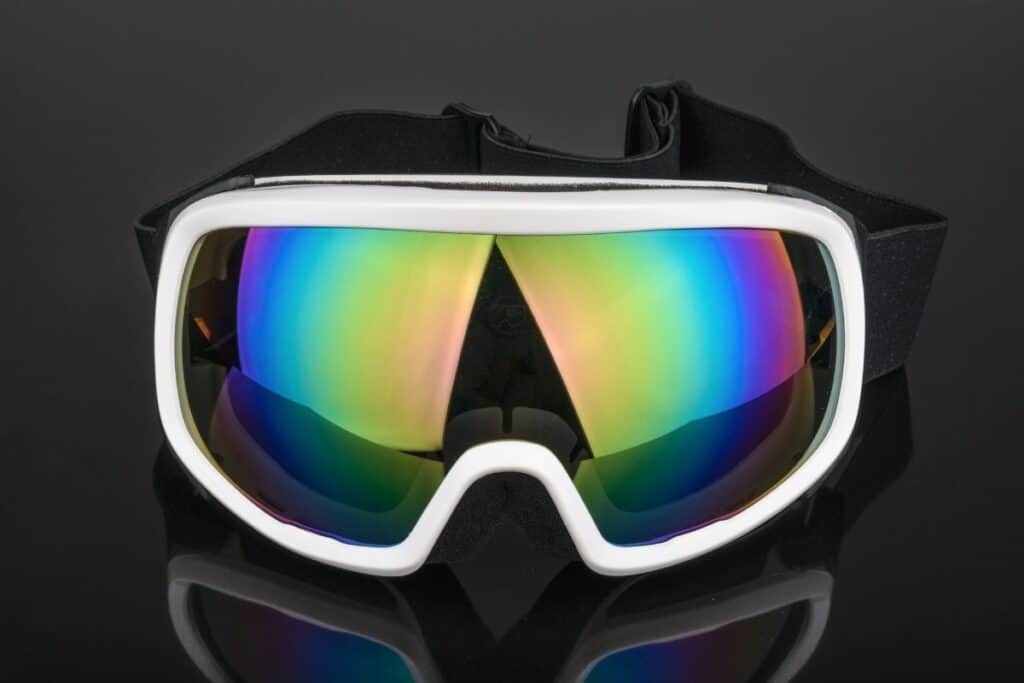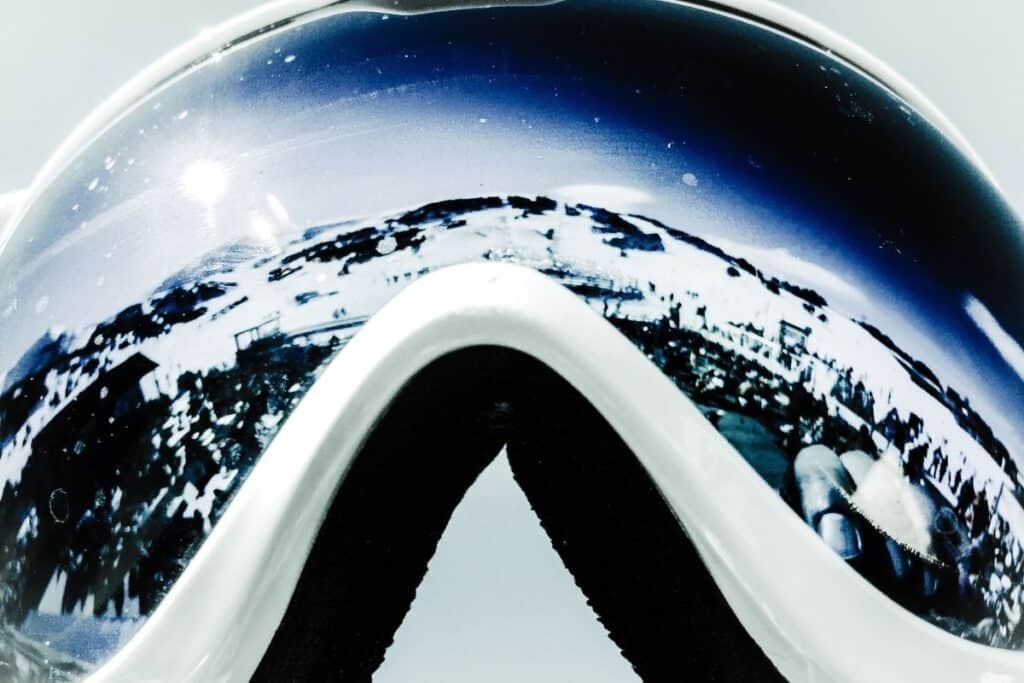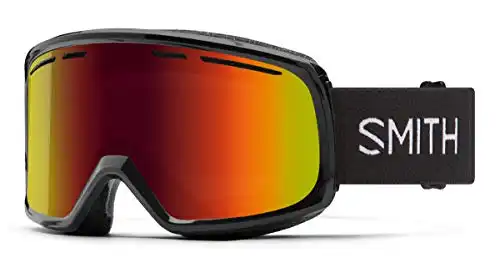
Many riders who are shopping for their first pair of ski goggles get hung up deciding between polarized vs. non-polarized lenses. There are some benefits and drawbacks associated with each style.
Not all ski goggles are polarized, however, many skiers prefer polarized lenses for their enhanced glare blocking, improved clarity, and reduced eye strain. Poor low light performance and added cost are the most common reasons for not using polarized ski goggles.
Read on, as I cover everything you need to know to select the best type of lenses when you hit the slopes!
Ski Goggle Lense Types
There are tons of brands and styles on the market, but there are only a few types of lenses for ski goggles.
While different lenses may have some special coatings or advanced features that make them optically superior, all lenses fall into two main categories: polarized or non-polarized.
Regular Lenses
Regular sunglass lenses protect from the sun’s UV rays and make it easier to see in bright conditions.
These lenses are made by adding a colored tint to the molten lens material as it’s being poured or applying it to clear lenses after they harden and cool.
Polarized Lenses
Polarized lenses are treated with a chemical application that applies an ultra-thin light filter to polarized glasses or goggles’ surface.
This filter restricts the light that can pass through the lenses, allowing only vertical light rays to reach your eyes while the horizontal rays are rejected.
When light reflects off a surface, like when the sun reflects off the snow, these reflected light rays are almost all horizontal.
The polarized filter blocks these horizontal rays, which almost completely eliminates glare in the process.
Mirrored Lenses
Mirrored lenses have a unique finish applied to the outside of the lens which provides a mirrored finish to the exterior of the lens. This coating reduces glare by reflecting much of the glare that reaches the lenses back towards its source.
Keep in mind that both regular and polarized lenses can have a mirror finish applied to them.
Riders who prefer a non-polarized lens will often opt for a mirror coating because it allows them to enjoy some of the benefits of polarized lenses with none of the drawbacks.
Many polarized lenses are also mirrored to provide additional glare reduction.
Benefits of Polarized Ski Goggles
There are several significant benefits that polarized lenses offer over regular lenses.
Here are the primary reasons why riders choose these goggles over non-polarized ones.
Benefit #1 – Glare Reduction
The most significant benefit of polarized lenses is they do an incredible job at cutting down on glare. In most situations, glare is manageable.
But when sunlight reflects off a flat plane, like when you’re on the water or cutting through some fresh powder, the glare can reflect directly into your eyes.
When the glare is especially bad, riders can be temporarily blinded, which presents a significant safety concern.
Plus, when you’re spending your day squinting to see through the glare, you end up putting undue stress on your eyes, leading to eye fatigue and headaches, putting a severe damper on your day on the mountain!
Benefit #2 – Improved Clarity
Not only can polarized lenses reduce glare, but they can also provide improved sharpness and clarity compared to non-polarized lenses.
A polarized lens filter improves contrast without much additional color distortion, and this effect is especially evident when conditions on the mountain are at their brightest.
While other riders are struggling to see on sunny days, those with polarized goggles enjoy sharper contrast and more defined vision.
Benefit #3 – More Vivid Colors
There are microscopic particles suspended in air that reflect light the same way as the snow on the ground. These reflections can cast a haze, causing the colors you see to appear duller than they are in reality.
As the polarized lens filters light, it also filters the reflections these particles generate, which makes the colors you’re seeing appear brighter and more vibrant, just how nature intended.
If you’re already enjoying some beautiful scenery as you ski or snowboard, polarized goggles can make the view appear even more impressive.
Benefit #4 – Reduced Eye Strain
We tend to squint when dealing with glare and extremely bright conditions, which allows our eyes to focus more clearly on what’s in front of us. Over time, the additional strain that squinting places on our eyes gets uncomfortable.
Eye strain leads to fatigue and discomfort, making it more difficult to see clearly and can lead to accidents on the slopes.
Plus, it can cause headaches which can ruin your time back at the lodge after the day is done.
Downsides of Polarized Ski Goggles
So far, it sounds like polarized goggles are a much better choice for you when you hit the slopes.
Before you grab a pair of polarized goggles for your next trip, there are a few downsides with polarized ski goggles you’ll want to consider before making your final decision.
Downside #1 – Poor Low-Light Performance
While polarized lenses are an ideal choice on exceptionally bright days, they don’t provide the same performance when it is not bright.
When riding on cloudy days, dusk, or at night, polarized lenses may be too dark, which can present a safety hazard.
Polarized lenses filter some of the light that would otherwise reach your eye, causing them to appear darker than non-polarized lenses.
The tint on polarized goggles is often darker than that of a non-polarized lens, which further contributes to their poor performance in low-light conditions.
Downside #2 – Difficult to See Ice
Slight changes in the surface of the snow are more difficult to see with polarized lenses compared to non-polarized.
In non-polarized goggles, it’s easier to pick out the more reflective slick spots on the snow’s surface that indicate an icy area you’d want to avoid.
With polarized goggles, the light blocking will filter out that additional reflectivity, and you’re much less likely to notice the icy spot until it’s too late.
Downside #3 – Difficult to See Screens
One of the cons of a polarized lens is that the filter on the lens doesn’t play well with LCD screens.
Some polarized goggles make digital screens extraordinarily dark and challenging to read, while others cause stray light to appear on the screen, making it equally difficult to read.
If you’re frequently checking your phone while you ski or snowboard, polarized lenses may make that much more difficult for you to do comfortably.
Downside #4 – Price
Another thing to consider with polarized goggles is their price. Polarized goggles tend to command a higher price tag than non-polarized.
If you’re shopping on a budget, you’ll need to consider whether the benefits of polarized lenses are worth the additional cash you’ll have to part with when you buy a pair.

Are Polarized Ski Goggles Worth It?
Now that we know the answer to the question “are ski goggles polarized”, the question becomes “are polarized ski goggles worth it?”
Like so many pieces of gear for the mountain, the answer boils down to a matter of personal opinion.
Most riders agree, the advantages of polarized goggles make them the superior choice. The few negatives associated with polarized goggles are a small price to pay for the added glare reduction and visual clarity that polarization provides.
Still, many riders prefer to wear non-polarized goggles for a number of reasons.
Perhaps your eyes are sensitive to the filtered light, or you want to be able to wear your goggles at night, or use your phone with your goggles still on. Whatever the reason may be, many riders prefer a regular lens in their goggles.
While you can easily spend hundreds (yes, hundreds!) of dollars on snow goggles, I find that this pair from Smith offers excellent value.
Even in the most challenging mountain conditions, the Smith Range snow goggles reduce fogging and help you see clearly with active ventilation and a hydrophilic Fog-X lens treatment.
But if you’re still unsure which lenses are best for you, try out both styles the next time you hit the slopes.
After a day on the mountain, you’ll know exactly which style of lenses are the right ones for you!
Related Articles
If you found this article helpful, then make sure to take a look at some of my other related articles linked below!

